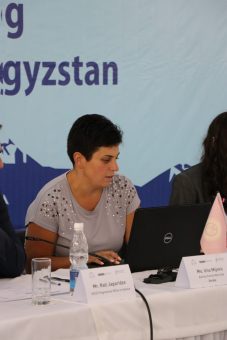
September was an important month for Serbia when it comes to the kind of impression we make on the world about our ecological awareness. The annual meeting of the Aarhus Centres was held on September 19 and 20, at Lake IssykKul in Kyrgyzstan. We talked to Una Mijovic, a delegate from Aarhus Centre in Novi Sad, who was invited by the OSCE Secretariat to represent Serbia at this year’s meeting. Una explained to us why Aarhus centres are important and in what way they help citizens to actively participate in decision-making at all levels of authority regarding the quality of the environment they live in.
EP: Explain to us what it is based on, starting from the very idea of Aarhus?
Una Mijovic: The Aarhus Convention or the Convention on the Access to Information, Public Participation in Decision-Making and Access to Justice in Environmental Matters was adopted on 28 June 1998 in Aarhus, Denmark. Its goal is to protect the right of individuals, present and future generations to live in an environment that is adequate for their health and well-being. The Republic of Serbia ratified it in 2009, thus taking the obligation to apply and implement its provisions into the legislation. The significance of the Aarhus Convention is derived from the need of every individual and the entire society to live in the healthy environment, either in a city or in a rural environment, to ensure better and healthier life for present and future generations. The quality of the environment significantly affects our health, and the implementation of the Aarhus Convention allows citizens to participate in decision-making actively and to achieve legal and judicial protection in case of the failure of its implementation. This year is the anniversary for the Aarhus Convention since it was adopted 20 years ago.
EP: There are so-called “three pillars” of the Aarhus Convention. What do they represent?
Una Mijovic: Yes, the Aarhus Convention is based on three pillars: access to information, public participation in decision-making and legal protection. The three listed pillars are envisaged as instruments for citizens to exercise their right to live in a healthy environment. The availability of information implies that the citizens have the right to receive accurate, complete and up-to-date information about the environment from relevant institutions and all levels of authority. The participation of the public in decision-making obliges decision-makers to involve the public in the process. This pillar also gives the public the right to be included in the decision-making. The legal protection represents the possibility and the right of the public to demand, before the courts, the compliance of the Convention and the implementation of the right from the first two pillars, in cases when their implementation was initially ceased.

EP: How do Aarhus Centres operate in Serbia?
Una Mijovic: Aarhus centres are civil society organizations whose goal is to establish cooperation between the citizens and relevant levels of authority, local municipalities, and even beyond that, the implementation of the provisions of the Convention. Their goal is to help all participants in making decisions on issues relevant to environment, and in strengthening their capacities in the implementation of environmental regulations. Aarhus centres should also ensure that the decision-making process in the environmental sector is democratic. There are five Aarhus centres in Serbia, based in Kragujevac, Nis, Novi Sad, Subotica and Belgrade. Together they form the Network of Aarhus Centres in Serbia. Aarhus Centres have been established under the auspices of the OSCE Mission in Serbia. Centres carry out their activities and projects and achieve their goals by mutual cooperation, communication and coordination.
EP: What are the pending issues in the Aarhus centres?
Una Mijovic: Topical themes that Aarhus centres in Serbia are dealing with are waste management, circular or green economy, recycling, water quality, climate change as well as meeting the conditions for opening the Chapter 27 in pre-accession negotiations. Aarhus Centre in Novi Sad has developed the Study on the progress towards the circular (sustainable) economy in Vojvodina. The Study identifies the challenges that are met on the way of implementing the circular economy in the construction and agriculture. It also identifies the drivers and blockers of eco-initiatives in Vojvodina and examples of good-practices in these areas. This Study is one big venture and the only one of this kind in Serbia.
EP: You have recently returned from the annual gathering of the Aarhus Centres in Kyrgyzstan. What was discussed at the Convention?
Una Mijovic: This year’s annual meeting of Aarhus Centres from several countries was held in Kyrgyzstan under the auspices of the OSCE in September. Representatives of 15 Aarhus Centres, relevant Ministries from different countries and international organisations attended this meeting. At the meeting, they shared the information on the activities of Aarhus Centres, experiences and projects that Aarhus Centres have been dealing with. Topics such as toxic waste management, with a special emphasis on the Centres involved in solving uranium problems in the countries of Central Asia, then strengthening the risk management capacities, reducing the risk of natural disasters and climate change at the local level, as well as the approach to water management and the promotion of green (sustainable) economy and resource efficiency at the local level were in the focus.
EP: What made the strongest impression on you at the Convention? Were new goals set up there and how would that affect Serbia?
Una Mijovic: The annual meeting showed the diversity of environmental problems and issues that countries in different parts of the world face while implementing the Aarhus Convention. The focus was on the conversation on how to achieve the goals the 2030 Agenda for Sustainable Development. By sharing ideas and experiences, we have come to the conclusions how we can implement our goals and influence the creation of a healthier and sustainable environment in a better way.
Prepered by: Milan Zlatanovic
Read the whole interview in the new issue of the Energy portal Magazine on CIRCULAR ECONOMY, September-November 2018.



